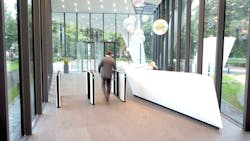In an ancient story, six people encounter an elephant for the first time. Without being able to see it, they each try to figure out what kind of an object it is. One person, feeling the trunk, decides it is like a snake. Another, feeling a leg, says it is like a tree. The story goes on with another judging the animal by its fan-like ear, another by its rope-like tail, etc. When you need to determine the right entry solutions for a customer’s facility, dealing with a number of different individuals can feel like trying to judge an elephant without seeing it – the contractor will focus on the prices, the architect on the aesthetics, and so on.
While these are all important factors, they must all be weighed and balanced against your customer’s security and business objectives before you can make the best recommendation to secure their premises. Purchasing entrance solutions can represent a significant investment for your customer, and so your expert guidance can prove invaluable.
There are eight factors that should go into an analysis of the different security entrances on the market. By taking all eight of these factors into consideration, you can help guide your customer to the best choice of entry solution for their organization. Along with this guidance, a security integrator can provide to help facilitate adoption of the new technology once it is deployed.
Providing this higher level of consultative support to customers will also make you a much more valuable partner for them when they are making these important decisions – now and in the future.
Factor No. 1: Security
One of the most important functions of security entrances is to help keep unwanted or unauthorized individuals off the premises. For each point where an entrance is to be installed, you will need to know the level of security needed for that location. The entrance to a data center, for example, will require a higher security level than the entrance to a lobby.
There are a number of questions to ask to help clarify the specifics of these differences. For example, many facility entrances do not provide for tailgating prevention, but it may be considered a necessity by your customer. In this case, you would want to limit recommendations to those security entrances which can control tailgating. Further, need to know whether the goal is to detect, deter or fully eliminate tailgating for each individual entry point, as each objective requires a different security entrance solution to fully meet the need.
Factor No. 2: Throughput
To calculate throughput, consider current and maximum building occupancy levels, employee workflows, elevator banks and waiting area capacities. The directional use of any entrance can change during the course of a workday. For example, during morning rush hours, there should be more inbound lanes open; in the afternoon it should be the other way around.
Other factors include whether one-way or two-way traffic is needed, and where access for the disabled or individuals transporting large items will be provided.
Too many entrances will waste financial and space resources. Too few will lead to lost time, lower productivity and frustrated users.
Factor No. 3: Aesthetics
The colors, materials and finishes of the entrances chosen will impact not only how an entrance looks when it is first installed, but how well it will support your customer’s security and business objectives over time.
Make sure your client considers whether they want the entrance to stand out or blend in with the facility, and if they want it to reflect corporate branding. Its look will speak volumes about the organization – it can be sleek and high-tech, rustic and friendly, or traditional. Finally, consider the practicalities such as exposure to the outdoors, cleaning and wear and tear over time.
Factor No. 4: Return on Investment
It may seem counterintuitive to think about return on investment for an entrance; however, there are factors to consider. Beyond the cost of the entrance itself, depending on the amount of traffic vs. the throughput of the entrance, the facility may need more than one unit.
Further, some entrances require more training, more maintenance or more energy to power over their lifespans, increasing costs; others require constant staff supervision.
Additionally, an entrance that collects and provides useful business or security data has an increased value that may be difficult to measure but is extremely meaningful to the organization.
Factor No. 5: Training
Beyond the installation, manufacturer technical training can help improve and increase the life of entrances. Training can also help reduce the number and length of service visits, saving costs for the user – a strong selling point.
Manufacturer training tools should include resources like webinars, on-site training and regular in-house training at the factory to keep technicians up to date on new technologies. Programs for installers should include technical training on installation, service, planned maintenance and post-installation issues.
An added bonus is end-user training and pre-installation orientation to help with everyday operation, troubleshooting and daily maintenance.
Factor No. 6: Safety
When people pass through automatic entrances with moving barriers, there is the chance of contact and potential injury. The key to avoiding this is finding a balance between the security and safety level needed, with a throughput level that works for the user. Proper training helps personnel use entrances more safely, along with visual instructions in clear view of all users.
The card reader itself should be clearly visible and placed where it can be accessible well in advance of the entrance opening – this way it is more likely to be used correctly and allows enough time for the entrance to open as needed.
The entrance itself should be configured to allow enough time for each individual to pass through. A balance point must be found with security and throughput, as more time increases the potential for tailgating, piggybacking or the formation of a long line.
Factor No. 7: Service
Not all providers offer the same level of service and support. Over the life of a security entrance, this increases the total cost of operations (TCO), both for the entrance itself and for the organization as a whole. Including service in your consideration will help your customer maximize their return on investment (ROI).
If a security entrance goes out of service, traffic may stack up at other secure entrances and the customer may need to hire security staff to maintain the level of security.
Opening additional entry points could also make it easier for an unauthorized individual to slip through, increasing the potential for risk, theft and liability. The longer the security entrance is out of service, the more the costs mount and the greater the risk of additional negative outcomes.
In assessing the various manufacturers, be sure to consider technical support, maintenance agreements and replacement parts. Look at where service technicians are located, which will influence the length of time it takes them to reach a job site.
Factor No. 8: Culture
Deploying security entrances at a facility can constitute a significant change for employees. Before the installation, it is important to consider and understand the values, environment and personality of the user’s organization and personnel. Find out how employees have reacted to changes in the past, if they have used security entrances, and what steps management has planned for training and orientation.
The new entrances should always be presented to onsite staff as a positive action being taken to help maintain a safer environment and improve peace of mind during their workday.
Maintaining open communication – along with responsiveness to any issues and complaints that arise during and after the implementation – will help your customer ease adoption and satisfaction, and ultimately lead to a successful installation.
Greg Schreiber is Senior VP of Sales for Boon Edam. Request more info about the company at www.securityinfowatch.com/10213074.
About the Author

Greg Schreiber
Senior Vice President of Sales & Marketing
Greg Schreiber has been with the company a total of 23 years and currently is the senior vice president of sales and marketing. Greg’s career spans over 28 years in the security entrance and door industry in a variety of sales management roles, including national sales manager from 2007-2012, vice president of sales from 2013-2016 and most recently his current role as senior vice president of sales and marketing. Since 2013, Greg has successfully steered the North American and global accounts sales teams to produce double-digit sales growth. A native of Pittsburgh, Greg graduated from the University of Toledo with a degree in Business Administration and currently lives in Venetia, Pa.
